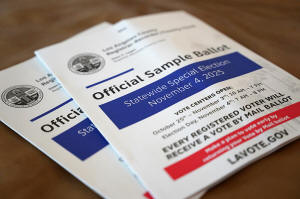Voting is underway in California on new maps that could swing US House
control, check Trump's power
[October 06, 2025]
By MICHAEL R. BLOOD
LOS ANGELES (AP) — The midterm elections might be a year away, but the
fight for control of the U.S. House is underway in California.
Voting opened statewide Monday on whether to dramatically reshape
California's congressional districts to add as many as five
Democrat-held seats in Congress — a possible offset to President Donald
Trump’s moves in Texas and elsewhere to help Republicans in the 2026
election.
The outcome of the 70-word, “yes” or “no” question could determine which
party wins control of the closely divided House, and whether Democrats
will be able to blunt Trump’s power in the second half of his term on
issues from immigration to reproductive rights.
The proposal is “a starting point for the 2026 race,” said Democratic
consultant Roger Salazar.
“2026 is the whole ball game,” he said.
The national implications of California's ballot measure are clear in
both the money it has attracted and the figures getting involved. Tens
of millions of dollars are flowing into the race — including a $5
million donation to opponents from the Congressional Leadership Fund,
the super PAC tied to House Speaker Mike Johnson. Former action-movie
star and Republican Gov. Arnold Schwarzenegger has spoken out to oppose
it, while former President Barack Obama is in favor, calling it a
“smart” approach to counter Republican maneuverings aimed at
safeguarding House control.
The election that concludes Nov. 4 will also color the emerging 2028
presidential contest in which Democratic Gov. Gavin Newsom — the face of
the campaign for the new, jiggered districts — is widely seen as a
likely contender.
So goes California, so goes the nation?
“Heaven help us if we lose,” Newsom wrote in a recent fundraising pitch
to supporters. “This is an all-hands-on-deck moment for Democrats.”

An election gamble that could check Trump's power
The unusual special election amounts to a Democratic gambit to blunt
Trump’s attempt in Texas to gain five Republican districts ahead of the
midterms, a move intended to pad the GOP’s tenuous grip on the House.
The duel between the nation’s two most populous states has spread
nationally, with Missouri redrawing House maps that are crafted state by
state. Other states could soon follow, while the dispute also has become
entangled in the courts.
A major question mark has emerged in Texas, where a panel of federal
judges is considering whether the state can use a redrawn congressional
map that boosts Republicans.
If the Texas map is blocked even temporarily, it's not clear how that
decision would influence California — if at all — where voting is
underway. Newsom has previously indicated that California could keep its
current map if other states pull back efforts to remake districts for
partisan advantage, but that language was not included in the final
version of what's officially known as Proposition 50.
GOP could be left with just four House seats in California
If approved in California, it’s possible the new political map could
slash five Republican-held House seats while bolstering Democratic
incumbents in other battleground districts. That could boost the
Democratic margin to 48 of California’s 52 congressional seats, up from
the 43 seats the party now holds.
Liberal-tilting California has long been a quirk in House elections —
the state is heavily Democratic but also is home to a string of some of
the most hotly contested congressional districts in the country, a
rarity at a time when truly competitive House elections have been
dwindling in number across the U.S.
[to top of second column]
|

A sample ballot is pictured before early voting starts in
California's statewide special election, Friday, Oct. 3, 2025, in
Los Angeles. (AP Photo/Paula Ulichney-Munoz)

The contours of the race have taken shape, with Newsom framing the
contest as a battle to save democracy against all things Trump,
while Republicans and their supporters decry the proposal as a
blatant power grab intended to make the state’s dominant Democrats
even more powerful while discarding House maps developed by an
independent commission. Democrats crafted the proposed lines behind
closed doors.
Republicans hold a 219-213 majority in the U.S. House, with three
vacancies.
New maps are typically drawn once a decade after the census is
conducted. Many states, including Texas, give legislators the power
to draw maps. California is among states that rely on an independent
commission that is supposed to be nonpartisan — the Democratic
ballot proposal would shelve that group's work and postpone its
operation until the next census.
Creative boundary lines create districts to favor Democrats
In some cases, the recast districts would slice across California,
in one case uniting rural, conservative-leaning northern California
with Marin County, a famously liberal coastal stronghold north of
San Francisco. In others, district lines are left unchanged or have
only minor adjustments.
With rural and farming areas in some cases being combined in new
districts with populous cities, there is “worry about us losing our
voice,” said John Chandler, a partner in almond-and-peach grower
Chandler Farms in the state’s Central Valley farm belt. “It hurts
us,” Chandler said during an online event organized by proposition
opponents.
Who will show up and vote?
Democrats come to the contest with significant advantages — they
outnumber registered Republicans in the state by a nearly 2-to-1
margin, and a Republican candidate hasn't won a statewide election
in nearly two decades.
Still, ballot questions can be unpredictable. Voters are in a grumpy
mood nationally and hold mixed views of both political parties.
It's difficult to determine precisely who might show up in an
election with no candidate on the statewide ballot — only a question
involving a constitutional amendment on the arcane subject of
redistricting, or the realignment of House district boundaries. And
campaigns are competing for attention in a nation of nonstop
distraction, from wars abroad to the political stalemate in
Washington.
Supporters and opponents are running a cascade of ads in the state's
big media markets. Trump is trying to “steal congressional seats and
rig the 2026 election,” one ad from supporters warns. Opponents are
spotlighting a recent appearance by Schwarzenegger, who in one ad
clenches his fist and says, “Democracy — we've got to protect it and
we've got to go and fight for it.”

In the state's Central Valley, Kelsey Hinton is working to mobilize
infrequent Latino voters hitched to hectic jobs and child care who
are often overlooked by major campaigns. Her group, the Community
Water Center Action Fund, dispatches canvassers to knock on doors to
explain the stakes in the election.
Operating separately from Newsom’s campaign, and backed by funding
from a left-leaning political group known as the Progressive Era
Issues Committee, they hope to boost voter participation in an area
where turnout can be among the sparsest in the state.
What are they finding? “People don’t even know there is an
election,” Hinton said.
All contents © copyright 2025 Associated Press. All rights reserved |